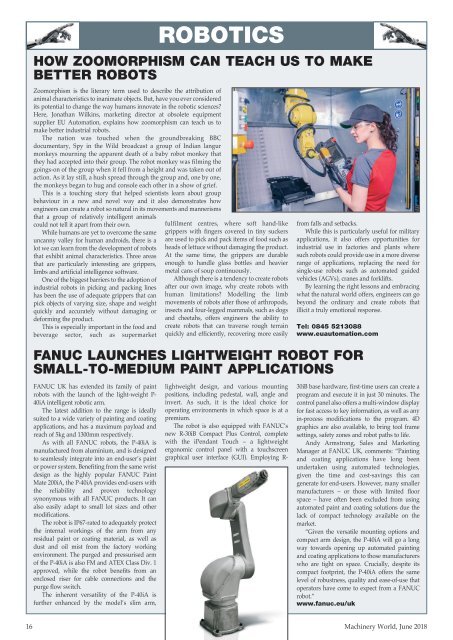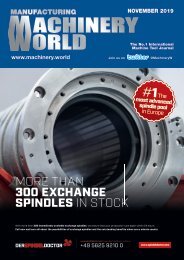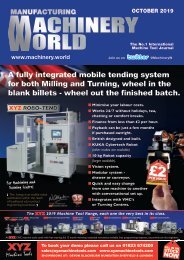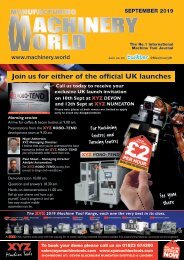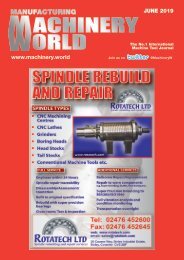Manufacturing Machinery World June 2018
Machinery World was launched in 1982 to serve the machinery & production engineering market. Editorially Machinery World is a news and information source that gives direct contact with the provider of innovative services and equipment. Editorial is available both online and as hard copy.
Machinery World was launched in 1982 to serve the machinery & production engineering market. Editorially Machinery World is a news and information source that gives direct contact with the provider of innovative services and equipment. Editorial is available both online and as hard copy.
You also want an ePaper? Increase the reach of your titles
YUMPU automatically turns print PDFs into web optimized ePapers that Google loves.
ROBOTICS<br />
HOW ZOOMORPHISM CAN TEACH US TO MAKE<br />
BETTER ROBOTS<br />
Zoomorphism is the literary term used to describe the attribution of<br />
animal characteristics to inanimate objects. But, have you ever considered<br />
its potential to change the way humans innovate in the robotic sciences?<br />
Here, Jonathan Wilkins, marketing director at obsolete equipment<br />
supplier EU Automation, explains how zoomorphism can teach us to<br />
make better industrial robots.<br />
The nation was touched when the groundbreaking BBC<br />
documentary, Spy in the Wild broadcast a group of Indian langur<br />
monkeys mourning the apparent death of a baby robot monkey that<br />
they had accepted into their group. The robot monkey was filming the<br />
goings-on of the group when it fell from a height and was taken out of<br />
action. As it lay still, a hush spread through the group and, one by one,<br />
the monkeys began to hug and console each other in a show of grief.<br />
This is a touching story that helped scientists learn about group<br />
behaviour in a new and novel way and it also demonstrates how<br />
engineers can create a robot so natural in its movements and mannerisms<br />
that a group of relatively intelligent animals<br />
could not tell it apart from their own.<br />
While humans are yet to overcome the same<br />
uncanny valley for human androids, there is a<br />
lot we can learn from the development of robots<br />
that exhibit animal characteristics. Three areas<br />
that are particularly interesting are grippers,<br />
limbs and artificial intelligence software.<br />
One of the biggest barriers to the adoption of<br />
industrial robots in picking and packing lines<br />
has been the use of adequate grippers that can<br />
pick objects of varying size, shape and weight<br />
quickly and accurately without damaging or<br />
deforming the product.<br />
This is especially important in the food and<br />
beverage sector, such as supermarket<br />
fulfilment centres, where soft hand-like<br />
grippers with fingers covered in tiny suckers<br />
are used to pick and pack items of food such as<br />
heads of lettuce without damaging the product.<br />
At the same time, the grippers are durable<br />
enough to handle glass bottles and heavier<br />
metal cans of soup continuously.<br />
Although there is a tendency to create robots<br />
after our own image, why create robots with<br />
human limitations? Modelling the limb<br />
movements of robots after those of arthropods,<br />
insects and four-legged mammals, such as dogs<br />
and cheetahs, offers engineers the ability to<br />
create robots that can traverse rough terrain<br />
quickly and efficiently, recovering more easily<br />
from falls and setbacks.<br />
While this is particularly useful for military<br />
applications, it also offers opportunities for<br />
industrial use in factories and plants where<br />
such robots could provide use in a more diverse<br />
range of applications, replacing the need for<br />
single-use robots such as automated guided<br />
vehicles (AGVs), cranes and forklifts.<br />
By learning the right lessons and embracing<br />
what the natural world offers, engineers can go<br />
beyond the ordinary and create robots that<br />
illicit a truly emotional response.<br />
Tel: 0845 5213088<br />
www.euautomation.com<br />
FANUC LAUNCHES LIGHTWEIGHT ROBOT FOR<br />
SMALL-TO-MEDIUM PAINT APPLICATIONS<br />
FANUC UK has extended its family of paint<br />
robots with the launch of the light-weight P-<br />
40iA intelligent robotic arm.<br />
The latest addition to the range is ideally<br />
suited to a wide variety of painting and coating<br />
applications, and has a maximum payload and<br />
reach of 5kg and 1300mm respectively.<br />
As with all FANUC robots, the P-40iA is<br />
manufactured from aluminium, and is designed<br />
to seamlessly integrate into an end-user’s paint<br />
or power system. Benefiting from the same wrist<br />
design as the highly popular FANUC Paint<br />
Mate 200iA, the P-40iA provides end-users with<br />
the reliability and proven technology<br />
synonymous with all FANUC products. It can<br />
also easily adapt to small lot sizes and other<br />
modifications.<br />
The robot is IP67-rated to adequately protect<br />
the internal workings of the arm from any<br />
residual paint or coating material, as well as<br />
dust and oil mist from the factory working<br />
environment. The purged and pressurised arm<br />
of the P-40iA is also FM and ATEX Class Div. 1<br />
approved, while the robot benefits from an<br />
enclosed riser for cable connections and the<br />
purge flow switch.<br />
The inherent versatility of the P-40iA is<br />
further enhanced by the model’s slim arm,<br />
lightweight design, and various mounting<br />
positions, including pedestal, wall, angle and<br />
invert. As such, it is the ideal choice for<br />
operating environments in which space is at a<br />
premium.<br />
The robot is also equipped with FANUC’s<br />
new R-30iB Compact Plus Control, complete<br />
with the iPendant Touch – a lightweight<br />
ergonomic control panel with a touchscreen<br />
graphical user interface (GUI). Employing R-<br />
30iB base hardware, first-time users can create a<br />
program and execute it in just 30 minutes. The<br />
control panel also offers a multi-window display<br />
for fast access to key information, as well as any<br />
in-process modifications to the program. 4D<br />
graphics are also available, to bring tool frame<br />
settings, safety zones and robot paths to life.<br />
Andy Armstrong, Sales and Marketing<br />
Manager at FANUC UK, comments: “Painting<br />
and coating applications have long been<br />
undertaken using automated technologies,<br />
given the time and cost-savings this can<br />
generate for end-users. However, many smaller<br />
manufacturers – or those with limited floor<br />
space – have often been excluded from using<br />
automated paint and coating solutions due the<br />
lack of compact technology available on the<br />
market.<br />
“Given the versatile mounting options and<br />
compact arm design, the P-40iA will go a long<br />
way towards opening up automated painting<br />
and coating applications to those manufacturers<br />
who are tight on space. Crucially, despite its<br />
compact footprint, the P-40iA offers the same<br />
level of robustness, quality and ease-of-use that<br />
operators have come to expect from a FANUC<br />
robot.”<br />
www.fanuc.eu/uk<br />
16 <strong>Machinery</strong> <strong>World</strong>, <strong>June</strong> <strong>2018</strong>


